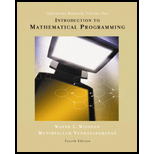
Explanation of Solution
a.
Determining A:
Let
Assume that rows for the matrix refer to the inputs and column for the matrix refer to the output.
Define steel as product 1, car as product 2, and machine as product 3.
Thus,
Therefore,
Similarly,
Therefore,
Explanation of Solution
b.
Proof:
It is given that s, c, and m represents the dollar value of steel, cars, and machines, produced in the economy respectively, and
Note that a product has two uses in the economy, one to produce other goods and the other one for the consumption. So, the total production of a product must be equal to the amount of that product used to produce other goods and the amount consumed, that is supply is equal to the demand.
For instance, for steel, its production must be equal to the dollar value of steel used in the steel’s production plus the dollar value of the steel used in the car’s production plus the dollar value of steel used in the machines production plus the dollar value of the steel’s consumption.
Similarly,
Explanation of Solution
c.
Proof:
Let,
Then, the equations (1), (2) and (3) can be written as,
Since a matrix multiplied by the identity matrix is the matrix itself, so the equation (4) can be further written as,
Subtract from both sides of the equation
Explanation of Solution
d.
Consider the equation derived in part (c.)
Pre-multiply both sides by
Explanation of Solution
e.
It is given that the demand for steel goes up by $1.
Denote the new production levels by
Then,
Thus, the change in production levels can be derived by subtracting equation (5) from the above equation (6).
Trending nowThis is a popular solution!

Chapter 2 Solutions
Introduction to mathematical programming
- Draw an ERD that will involve the entity types: Professor, Student, Department and Course. Be sure to add relationship types, key attributes, attributes and multiplicity on the ERD.arrow_forwardDraw an ERD that represents a book in a library system. Be sure to add relationship types, key attributes, attributes and multiplicity on the ERD.arrow_forward2:21 m Ο 21% AlmaNet WE ARE HIRING Experienced Freshers Salesforce Platform Developer APPLY NOW SEND YOUR CV: Email: hr.almanet@gmail.com Contact: +91 6264643660 Visit: www.almanet.in Locations: India, USA, UK, Vietnam (Remote & Hybrid Options Available)arrow_forward
- Provide a detailed explanation of the architecture on the diagramarrow_forwardhello please explain the architecture in the diagram below. thanks youarrow_forwardComplete the JavaScript function addPixels () to calculate the sum of pixelAmount and the given element's cssProperty value, and return the new "px" value. Ex: If helloElem's width is 150px, then calling addPixels (hello Elem, "width", 50) should return 150px + 50px = "200px". SHOW EXPECTED HTML JavaScript 1 function addPixels (element, cssProperty, pixelAmount) { 2 3 /* Your solution goes here *1 4 } 5 6 const helloElem = document.querySelector("# helloMessage"); 7 const newVal = addPixels (helloElem, "width", 50); 8 helloElem.style.setProperty("width", newVal); [arrow_forward
- Solve in MATLABarrow_forwardHello please look at the attached picture. I need an detailed explanation of the architecturearrow_forwardInformation Security Risk and Vulnerability Assessment 1- Which TCP/IP protocol is used to convert the IP address to the Mac address? Explain 2-What popular switch feature allows you to create communication boundaries between systems connected to the switch3- what types of vulnerability directly related to the programmer of the software?4- Who ensures the entity implements appropriate security controls to protect an asset? Please do not use AI and add refrencearrow_forward
 Operations Research : Applications and AlgorithmsComputer ScienceISBN:9780534380588Author:Wayne L. WinstonPublisher:Brooks Cole
Operations Research : Applications and AlgorithmsComputer ScienceISBN:9780534380588Author:Wayne L. WinstonPublisher:Brooks Cole C++ for Engineers and ScientistsComputer ScienceISBN:9781133187844Author:Bronson, Gary J.Publisher:Course Technology Ptr
C++ for Engineers and ScientistsComputer ScienceISBN:9781133187844Author:Bronson, Gary J.Publisher:Course Technology Ptr C++ Programming: From Problem Analysis to Program...Computer ScienceISBN:9781337102087Author:D. S. MalikPublisher:Cengage Learning
C++ Programming: From Problem Analysis to Program...Computer ScienceISBN:9781337102087Author:D. S. MalikPublisher:Cengage Learning


